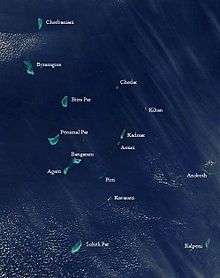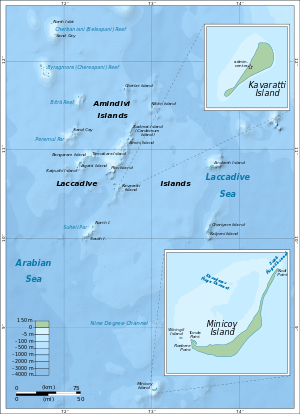Cherbaniani Reef
| Native name: <span class="nickname" ">Malayalam: Valiyapanniyam Nickname: Baliypanni Reef | |
|---|---|
 Cherbaniani Atoll Location of Cherbaniani Atoll in Lakshadweep | |
| Geography | |
| Location | Arabian Sea |
| Coordinates | 12°18′N 71°53′E / 12.300°N 71.883°ECoordinates: 12°18′N 71°53′E / 12.300°N 71.883°E |
| Archipelago | Lakshadweep |
| Adjacent bodies of water | Indian Ocean |
| Total islands | 3 |
| Major islands |
|
| Area | 0.015 km2 (0.0058 sq mi)[1] |
| Highest elevation | 2 m (7 ft) |
| Administration | |
| Territory | Union territory of Lakshadweep |
| District | Lakshadweep |
| Island group | Aminidivi |
| Tehsils of India | Aminidivi |
| Subdivisions of India | Bitra |
| Demographics | |
| Demonym | Malayali |
| Population | 0 (2014) |
| Pop. density | 0 /km2 (0 /sq mi) |
| Ethnic groups | Malayali, Mahls |
| Additional information | |
| Time zone | |
| Official website |
www |
| ISO Code | IN-LD-01[2] |
| Avg. summer temperature | 32.0 °C (89.6 °F) |
| Avg. winter temperature | 28.0 °C (82.4 °F) |
| unit_pref | Metric |
Cherbaniani Reef, also known as Beleapani Reef (Malayalam: Valiyapanniyam), is a coral atoll[3] belonging to the Amindivi Subgroup of islands of the Union Territory of Lakshadweep, India. It has a distance of 1,880 km (1,170 mi) south of the city of Delhi.
Geography
Cherbaniani Reef is located 33 km north of Byramgore Reef and at 12°18′N 71°53′E / 12.300°N 71.883°E it is the northwesternmost feature of Lakshadweep. The atoll has a roughly oval shape and was first described by ornithologist Allan Hume in 1876;[4] its total lagoon area is 57.46 km2 (22.19 sq mi).[5][6] The 14 km long coral reef that encloses the lagoon has three small uninhabited islands on it.
Ecology
They are composed of accumulated coral sand, shingle, cuttle-bones and sea shells. There are many land hermit crabs under the boulders and among the detritus.[7] The atoll used to be a breeding ground for pelagic birds, including the sooty tern (Sterna fuliginosa) and brown noddy (Anous stolidus), which were formerly found in great numbers.[8]
Demographics
North Islet has a small seasonal guano camp.
Economics
Lakshadweep islanders from Chetlat and Bitra sometimes visit the islands to collect guano for the gardens of the inhabited islands, gathering eggs, dumping garbage and disturbing the nestlings of pelagic birds in the process. The beaches are strewn with marine litter composed mainly of oceanic flotsam deposited by currents, such as plastic bottles, glass bulbs, polystyrene foam and cans.[9]
Administration
The Atoll belongs to the township of Bitra of Aminidivi Tehsil.[10]
Image gallery
 Satellite picture showing the atolls of the Lakshadweep except for Minicoy
Satellite picture showing the atolls of the Lakshadweep except for Minicoy Map
Map
References
- ↑ "Islandwise Area and Population - 2001 Census" (PDF). Government of Lakshadweep.
- ↑ Registration Plate Numbers added to ISO Code
- ↑ Cherbaniani Reef, India
- ↑ Hume, Allan O., The Laccadives and the West Coast, Stray Feathers. (Calcutta), IV (1876), 413-83. 21.
- ↑ Cherbaniani Reef - Oceandots at the Wayback Machine (archived December 23, 2010)
- ↑ Mistakenly switched here between Byramgore and Cherbaniani.
- ↑ W.A. Taylor, FRSE, Geographical Notes, Scottish Geographical Magazine, Volume 8, Issue 11, 1892
- ↑ Birds of Lakshadweep Islands Archived January 12, 2012, at the Wayback Machine.
- ↑ P.S.B.R. James, The Lakshadweep: Islands of Ecological Fragility, Environmental Sensitivity and Anthropogenic Vulnerability, Journal of Coastal Environment
- ↑ Tehsils info
| Wikimedia Commons has media related to Bitra. |
 Lakshadweep travel guide from Wikivoyage
Lakshadweep travel guide from Wikivoyage
External links
- Hydrographic Description (Indian Ocean Pilot)
- Lagoon sizes
- Cherbaniani Reef - Geographical information
- Seamount Catalog - Cherbaniani Reef Seamount
- List of Atolls
- Sources towards a history of the Laccadive Islands
- An ornithological expedition to the Lakshadweep archipelago